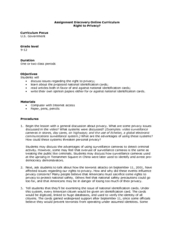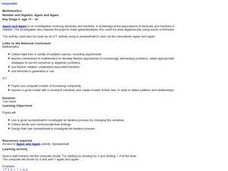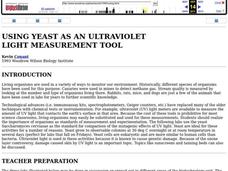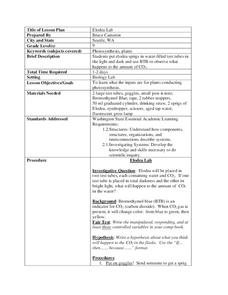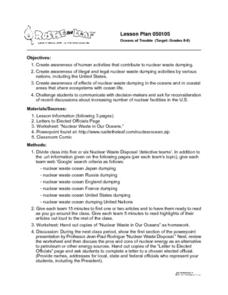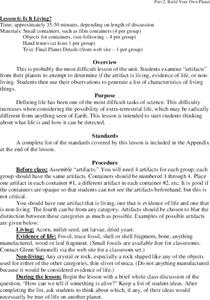Curated OER
Finding the Subject
Students explore sentences to locate subjects. In this language lesson, students investigate methods to locate subjects in sentences and practice doing so.
Curated OER
Assignment Discovery Online Curriculum Right to Privacy?
Students explore privacy rights. In this civics lesson plan, students investigate the pros and cons of proposed national identification cards as they explore provided Internet links. Students write position papers pertaining to the...
Curated OER
Sweet-Talkers
Learners investigate what is being sold to them. In this media awareness lesson plan, students visit selected websites to take a closer look at advertising marketed at them. Learners discuss the implications of marketing geared toward...
Curated OER
Applied Science - Science and Math Post-Lab
Students use scientific tools. In this Applied Science lesson, students investigate the use of scientific tools to enhance observation and discovery. Students indicate how each tool assists scientific work.
Penguin Books
A Teacher's Guide to The Omnivore’s Dilemma: A Natural History of Four Meals by Michael Pollan
"What should we have for dinner?" "What am I eating?" "Where did it come from?" These three questions are at the heart of Michael Pollan's The Omnivore's Dilemma: A Natural History of Four Meals. Pollan's book provides some very...
Curated OER
Exhaust, Gas and Pollution
Students watch a demonstration of how bromthymol blue is used to indicate the presence of carbon dioxide in a gas. They design their own experiments to test gasses which are suspected of containing carbon dioxide.
Curated OER
The Magnetic Sun
Students follow steps to build a simple version of a magnetometer, an instrument capable of detecting areas of strong magnetic field. Students use the magnetometer to investigate models of the Sun and examine images of the Sun.
Curated OER
DNA Fingerprinting with Restriction Enzymes
Students will illustrate how restriction enzymes work by piecing together parts of a puzzle. Then they apply this knowledge to help them analyze genetic evidence from the scene of a crime as well as to help them comprehend how a DNA...
Curated OER
Is There Seaweed/Algae in Your Food?
Students discover that seaweed/algae is a small part of the resources the oceans provide. By investigating common household products, students discover that human senses are not enough to detect the presence of seaweed/algae in food.
Curated OER
Compare Your Air
Students will compare the data for different locations that they select and investigate trends over the course of a number of years. This will give the students an opportunity to apply statistical measures (mean, median,mode) to data...
Curated OER
Mysterious Music
Eighth graders investigate how to compose music for a detective program. The goal is for them to discover the method needed. The idea was simple, they were told to compose the music with emotional tension that climaxed and then relaxed...
Curated OER
Number and Algebra: Again and Again
Students use a given spreadsheet to investigate an iterative process by changing the variables. They design their own spreadsheet to investigate the iterative process.
Curated OER
Evaluating Informaton Quality
Sixth graders investigate the concept of the quality of information that is used to conduct research. They begin to conceive the differences between information that is fact or fiction. Students write a critique of an information source...
Curated OER
and and Ocean Views of Earth by Remote Sensing
Students explain how satellites help scientists to see more than with the unaided eye and how Landsat technology works. Students identify vegetation and fire sites in the rainforest and detect erosion along rivers. They are able to use...
Curated OER
Searching the Attic
Students investigate an attic or basement to "discover" family artifacts. They develop a grid map using string, create a naming system for the grid, and analyze items of interest.
Curated OER
Classroom Triangles
Students use bearing measurements to triangulate and determine objects' locations. Working in teams of two or three, students must put on their investigative hats as they take bearing measurements to specified landmarks in their...
Curated OER
Using Yeast as an Ultraviolet Light Measurement Tool
Students accurately measure the relationship between radiation dose and either survival or some genetic event such as mutation or recombination. They investigate the damage that was done to the DNA molecule as a result of exposure to...
Curated OER
Biology: Howler Monkeys Tell All
Students examine a PBS special about howler monkeys as an introduction to scientific forensic investigative methods. In groups, they conduct a host of experiments containing clues which point to discovery. By challenging assumptions,...
Curated OER
Elodea Lab
Students observe the changes between elodea leaves placed in darkness and light. In this life science lesson, students experiment to find evidence of photosynthesis in elodea leaves. Students use indicators to detect the presences of...
Curated OER
The Case of the Mysterious Red Light
Students investigate why some sunrises and sunsets are unusually bright red.
Curated OER
The Inside Story
Students think about and investigate some of the social problems facing their communities: what causes them; how extensive they are; and what can be done to solve them.
Curated OER
Mission Planning: Geography
Students investigate the use of latitude and longitude to locate specific locations on Earth and evaluate that location as a potential landing site for researchers, terrestrial or alien space missions.
Curated OER
Oceans of Trouble
Pupils investigate the illegal and legal nuclear waste dumping activities by various nations, including the United States. The effects of nuclear waste dumping in oceans and in coastal areas that share ecosystems with ocean life is...
Curated OER
Is It Living?
Students investigate the definition of life and alive in the context of a unit that is involved with building their own planet. They participate in a class discussion about defining life, and in small groups analyze artifacts to...



